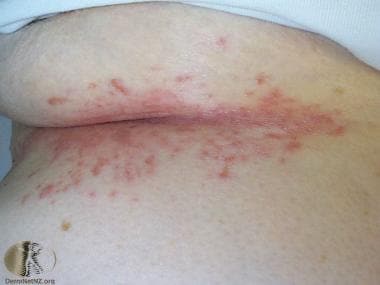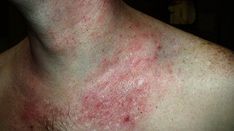Practice Essentials
Background
Intertrigo (intertriginous dermatitis) is an inflammatory condition of skin folds, induced or aggravated by heat, moisture, maceration, friction, and lack of air circulation.
Intertrigo frequently is worsened by infection, which most commonly is with Candida species. Bacterial, viral, or other fungal infection may also occur.
Intertrigo commonly affects the axilla, perineum, inframammary creases, and abdominal folds. Uncommonly, it can also affect the neck creases and interdigital areas.
Signs and symptoms of intertrigo
Intertrigo usually is chronic with an insidious onset of itching, burning, pain, and stinging in the skin folds.
Intertrigo initially presents as mild erythematous patches on both sides of the skinfold. The erythematous lesions may progress to weeping, erosions, fissures, maceration, or crusting.
Worsening erythema or inflammation could suggest the development of a secondary cutaneous infection.
Etiology of intertrigo
Intertrigo develops from mechanical factors and secondary infection. Heat and maceration are central to the process. Opposing skin surfaces rub against each other, at times causing erosions that become inflamed.
Secondary cutaneous infections can be caused by a variety of gram-positive or gram-negative bacteria or fungi, including various yeasts and dermatophytes.
Diagnosis of intertrigo
Basic microbiologic diagnostic studies can be performed to identify a potential causative agent of intertrigo and guide antimicrobial therapy.
Potassium hydroxide (KOH) test, Gram stain, or culture is useful to exclude primary or secondary infection and to guide intertrigo therapy.
A skin biopsy generally is not required unless the intertrigo is refractory to medical treatment.
Treatment of intertrigo
Simple intertrigo may be treated with drying agents
Infected intertrigo should be treated with a combination of an appropriate antimicrobial agent (antifungal or antibacterial) and low-potency topical steroid.
Prevention of intertrigo
During patient instruction, emphasize topics such as weight loss, glucose control (in patients with diabetes), good hygiene, and the need for daily care and monitoring. Additionally, preventative measures to reduce skin-on-skin friction and moisture can help in the management of current intertrigo and prevent future episodes.
Complications
Since intertrigo frequently is colonized or secondarily infected, secondary cutaneous infections and acute cellulitis can occur.
Background
Intertrigo (intertriginous dermatitis) is an inflammatory condition of skin folds, induced or aggravated by heat, moisture, maceration, friction, and lack of air circulation. [1] Intertrigo frequently is worsened by infection, which most commonly is with Candida. Bacterial, viral or, other fungal infection may also occur. Intertrigo commonly affects the axilla, perineum, inframammary creases, and abdominal folds, and it can also affect the neck creases and interdigital areas. [2, 3] Diaper dermatitis shows significant overlap with intertrigo. Intertrigo is a common complication of obesity and diabetes. [4]
See the image below.
Pathophysiology
Intertrigo develops from mechanical factors and secondary infection. Heat and maceration are central to the process. Opposing skin surfaces rub against each other, at times causing erosions that become inflamed. [1] Sweat, feces, urine, and vaginal discharge may aggravate intertrigo in both adults and infants.
Etiology of Intertrigo
Initiating factors include skin-on-skin friction, perspiration, maceration, trapping of moisture in deep skin folds, or irritation from stool, urine, drainage, or topical agents. [5] Autoeczematization and infection also may be factors in intertrigo. [1]
Whether infectious agents play a primary role in intertrigo or simply are common secondary agents is controversial. [1]
Epidemiology
Frequency
Intertrigo is common, especially in hot humid environments. Intertrigo is a common complication of diabetes, and it affects many infants as a component of diaper dermatitis.
Race
Intertrigo has no racial predilection.
Sex
Intertrigo has no sex predilection.
Age
Intertrigo affects people who are very old and very young because of reduced immunity, immobilization, and incontinence.
Prognosis
With preventative measures and therapy, the prognosis for each episode of simple intertrigo is excellent; however, recurrence is common. As a complication of more serious disease, intertrigo should be considered a comorbidity. Intertrigo becomes most serious as a source of secondary infection.
Patient Education
During patient instruction, emphasize topics such as weight loss, glucose control (in patients with diabetes), good hygiene, and the need for daily care and monitoring. [6] Additionally, preventative measures to reduce skin-on-skin friction and moisture can help in the management of current intertrigo and prevent future episodes. [1]
-
Intertrigo. Courtesy of DermNet New Zealand (http://www.dermnetnz.org/assets/Uploads/fungal/candida-intertrigo/1308.jpg).











